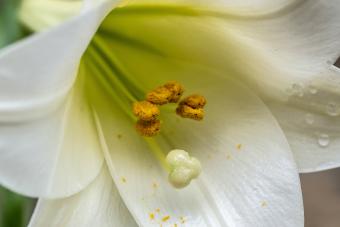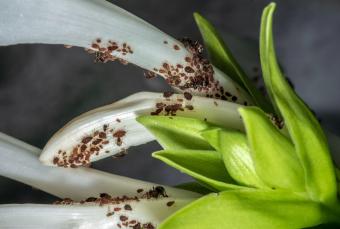
Easter lilies start showing up everywhere from nurseries to grocery stores in the weeks before the holiday, and they're hard to resist. Whether it's because you're longing for some beauty in your home, or because you appreciate this Easter plant's role as a symbol of hope and purity, Easter lilies aren't a bad choice as far as impulse purchases go. There are a few things to keep in mind, though, especially if you share your home with furry friends.
Easter Lilies

Easter lilies, or Easterlilies, as some refer to them, are true lilies and botanically known as Lilium longiflorum. They produce several pure white, trumpet-shaped flowers held aloft on a thick stem that usually grows about 12 inches tall when grown indoors.
Like all lilies, Easter lilies are very fragrant, able to perfume an entire room with their sweet, heady scent. Their pure white blooms and dark green, strappy foliage work well in any setting, though there are a few things you might want to keep in mind.
Most importantly, Easter lilies are toxic to cats. Ingesting them can cause kidney failure, so if you have cats and decide to also have Easter lilies, it's best to keep them in a room that your cats don't have access to. While they're not as toxic to dogs, they can still cause stomach upset, so it's a good idea to keep them out of the reach of dogs as well.
In addition, the bright yellow pollen of Easter lilies can stain clothing, table linens, and furniture. To prevent this from happening, the best option is to wrap the dangling pollen at the tips of the anthers in a napkin or paper towel, then snip the antlers off of the plant with scissors or floral shears. It won't harm the lily to do this, but it will avoid some messes, which is always a good thing.
Caring for Potted Easter Lilies
A few weeks before Easter, these fragrant flowers will start showing up in nurseries, home centers, and even grocery and big box stores. They're generally planted in a plastic pot set inside a foil or plastic decorative sleeve. They're fairly inexpensive, and have been forced by the growers so that they'll bloom for the Easter holiday (outdoors, these lilies bloom during the summer).
They're very easy to care for. They need even watering, so water them when the top inch or two of soil is dry to the touch, letting the water drain through the pot. One thing to keep in mind: it's important to remove the pot from the foil or plastic liner it was sold in and pour out any excess water so your plant isn't sitting in it. Sitting in water will cause the roots and bulb to rot.
- You don't need to fertilize potted Easter lilies, since there's usually slow-release fertilizer in the potting mix the grower planted the lily in.
- Place your potted Easter lily in a spot where it gets bright, indirect light.
- Eventually, the flowers will shrivel. You can pull them off when they start looking sad.
At the end of their bloom period, many people toss or compost their Easter lilies. But these are perennial plants in many areas, so if you have a spot in your garden, considering planting it outside.
Planting and Growing Easter Lilies in Your Garden

Easter lilies are perennial in Zones 5 through 9 (though sometimes they can also survive Zone 4, as long as they have some winter protection). Outdoors, they'll grow to about two to three feet tall and one foot wide, and instead of blooming in spring, they'll bloom in mid to late summer.
There are a few steps to follow if you want to plant your potted Easter lily outdoors.
- Keep the potted lily inside until after your last spring frost date, since it's not yet acclimated to outdoor conditions and harsh weather might stress it. Continue watering it even after the flowers fade, until you can harden it off.
- Harden the plant off after your frost date by moving it to a sheltered area outdoors for a few days and then bringing it inside at night. Then, move it to less-sheltered spots and leave it in a sheltered spot outdoors overnight for a few days. After it's gone through this hardening off process, you can plant your Easter lily in the garden.
- Plant it in a spot that gets full sun to partial shade, in fertile, well-drained soil. Dig a hole as deep as the lily was growing in its pot, the place the lily in the hole and backfill, then water well.
- Water the lily regularly, especially during dry spells. Like many perennials, it will die back in winter, and then sprout new growth in the spring.
- Fertilize with composted manure or slow release fertilizer when new growth appears, and you're good to go.
Your lily will bloom reliably for you year after year, adding beauty and fragrance to your summer garden.
Easter Lily Pests and Diseases

Easter lilies don't have many disease or pest issues. Occasionally, aphids can be a problem.
Outdoors, lily plants can get up to three feet tall, so if yours is in a windy or otherwise open area, you might need to stake it to keep the stalk from breaking when it's heavy with blooms.
Easter Lily Varieties

If you want to force your own Easter lilies or buy bulbs to plant directly into your garden, there are a few different varieties you might want to consider. Most of them, of course, have pure white blooms, but they vary in size and the number of blooms they produce. These are all varieties of Lilium longiflorum.
- 'Elegant Lady' is also known as the pink Easter lily, and produces fragrant, soft pink flowers.
- 'Nellie White' is the type of lily most often sold in stores as Easter lilies, so if you love these classic types and want more of them in your garden, this is the variety to look for.
- 'Triumphator' has large, fragrant white flowers with soft pink centers.
- 'Deliana' is the one for you if you love yellow flowers; this variety blooms in soft, buttery yellow.
- 'White Elegance' is similar to 'Nellie White' in that it has pure white blooms, but it produces more flowers per stalk, and the flowers are a bit smaller than those of 'Nellie White.'
- 'White Heaven' is another white Easter lily variety. It produces large, seven-inch flowers that are very fragrant.
Lilies for Easter and Beyond
If you love Easter lilies, there's no reason you have to say goodbye to them at the end of the season. If you have the space, plant them in your garden so you can enjoy them year after year.







